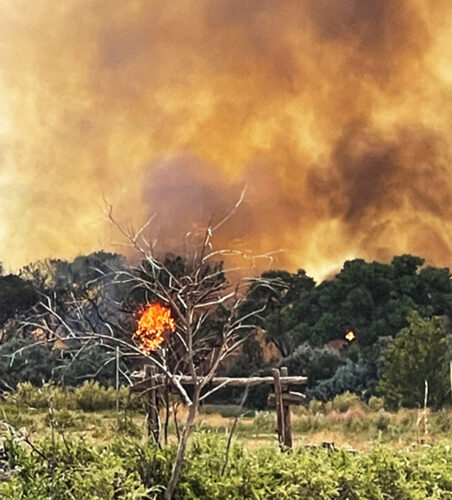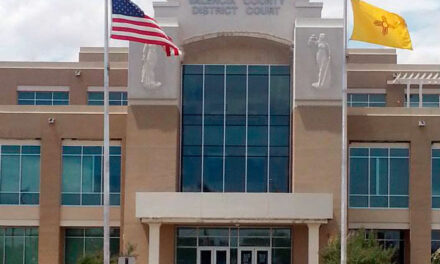The investigation of a wildfire that burned hundreds of acres of bosque in Valencia County this summer is complete.
The origin and cause report on the Cemetery Fire concluded the fire was human caused, but due to the lack of evidence at the scene and conflicting hypothesis, the precise cause is undetermined.

Photo courtesy of Angela Cano
Flames could be seen from N.M. 304 in the bosque east of the Rio Grande in June during the Cemetery Fire.
According to Valencia County Fire Department officials, the fire started shortly after noon on Saturday, June 12, on the east side of the Rio Grande, just north of the N.M. 346 bridge over the river, then jumped to the west side of the Rio Grande.
By 3 p.m., about 76 acres had been burned north of the river bridge. That evening, the fire jumped to the west side of Jarales Road, west of the Rio Grande, near Hernandez Road. No homes were lost to the blaze but two outbuildings did burn. The name of the fire came from a pet cemetery near where the fire started.
The origin and cause report was written by lead investigator Lt. Tobias Lucero with the Bernalillo County Fire Department. The two assisting investigators were from BCFD and the city of Santa Fe Fire Department.
The investigators determined the specific area of origin was on the north side of N.M. 346, just west of the bridge that crosses the Rio Grande.
“We found several items that could potentially be a competent ignition source for the fire,” Lucero wrote. “We found smoking material, fire work wrapping and vehicle components.
“We did note signs of human activity in the specific area of origin. We found several alcoholic beverage containers that appear to have been left behind within a day or two. We did not locate any incendiary devices.”
The report noted the area had been covered with blooms — cotton — from the cottonwood trees throughout the area.
“This type of litter is very fine and flashy, easily ignited by most competent ignition sources,” Lucero wrote.
Using the Guide to Wildland Fire Origin and Cause Determination Hand Book, April 2016 Edition, Lucero and the investigators documented possible causes for the fire, which were either excluded or deemed a possible cause.
Possible causes included incendiary, smoking, equipment and other miscellaneous causes such as target shooting, fireworks or power lines.
The report states incendiary, or arson fires, are defined as fires started deliberately and with willful or malicious intent. Investigators didn’t find an incendiary device in the origin area, which could have been due to what is called “hot set,” which is when the ignition source could have been an open flame or other portable device able to produce enough heat to ignite a fuel source.
A very narrow range of environmental conditions and physical circumstances — including temperature, relative humidity, wind speed and direction and fuel moisture — must be present for a cigarette to successfully ignite a wildland fire, the report reads. Investigators found cigarette remains in several areas of the area of origin.
The report includes equipment as a possible cause, noting the area of origin was near an active roadway, with ignition sources, such as exhaust particles.
Possible causes in the miscellaneous category are numerous, including power lines, fireworks, blasting, cutting, welding and grinding, reflective glass and spontaneous combustion.
“There were no power lines near the general or specific origin areas,” the report reads. “Investigators did find packaging from a single firework near the roadway, however it appeared to be weathered.”
Excluded causes were lightning, camp fire, debris burning, railroad activities and children.
No lightning strikes were noted in the area for several months leading up to the fire, and the investigation team couldn’t find any physical signs of a lightning strike near the ignition area.
The investigators didn’t find evidence of a camp fire in the area or a barbecue or gas camp stove, the report notes.
“Campfires also leave physical remains in the form of coals and partially burned fuels that are easily recognizable due the volume and arrangement,” Lucero wrote, continuing to write there was no obvious signs of camping activity near the origin areas.
Investigators did not find evidence of debris burning in the area and there are no railroad operations near the origin area of the fire.
Ignition activities associated with children was also excluded as a possible cause since the origin was in a remote area far from any schools, parks, playgrounds or residential homes.
“No evidence of children, such as small footprints, discarded candy wrappers, juice containers, toys or clothing (was) found by the investigation team,” the report reads. “… witness interviews revealed no evidence of children in or near the origin area …” when the fire started.
Cemetery Fire: Origin & Cause Report
Julia M. Dendinger began working at the VCNB in 2006. She covers Valencia County government, Belen Consolidated Schools and the village of Bosque Farms. She is a member of the Society of Professional Journalists Rio Grande chapter’s board of directors.
















